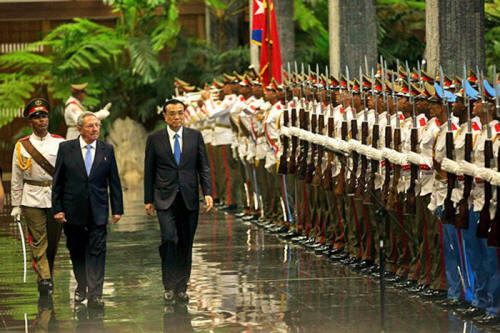|
by William M. LeoGrande October 11, 2016 from WPR Website
Cuban President Raul Castro and Chinese Premier Li Keqiang at Revolution Palace, Havana, Sept 24, 2016 (Cubadebate photo by Ismael Francisco via AP).
Recent visits to Cuba by a bevy of European and Asian leaders highlight a key element of Raul Castro's foreign policy that he has pursued alongside normalization with the United States:
Cuba learned this lesson the hard way...
Pre-revolutionary dependence on the United States, followed by post-revolutionary dependence on the Soviet Union, twice plunged Cuba into economic crisis when those ties were severed.
Although less drastic, the current
austerity triggered by the decline in oil shipments from
Venezuela underscores the danger of relying on a single foreign
partner.
Hundreds of business proposals from
U.S. firms are flooding the Cuban bureaucracy.
Russia's resurgence in the Caribbean traces back to Putin's 2000 trip to Cuba, which resulted in expanded trade deals, followed by Castro's 2009 visit to Moscow, his first since the end of the Cold War.
Prime Minister Dmitry Medvedev traveled to Cuba in February 2013, signing a number of agreements on trade and scientific cooperation.
In July 2014, Putin visited the island and agreed to forgive 90 percent of Cuba's $32 billion in Soviet-era debt, with the remainder to be retired through debt-equity swaps linked to Russian investments.
By the time Castro
went
to Moscow again in 2015, Russia had signed agreements to
invest in airport construction, development in the port of
Mariel, metallurgy and oil exploration. It also agreed to lend
Cuba more than $1.3 billion to develop thermal energy plants.
Diplomatically, Cuba supports the Russian positions on Ukraine, Syria and NATO expansion. Militarily, Russia is refurbishing and replacing Cuba's aging Soviet-era arms.
Russian naval vessels visit Cuban ports, the most prominent being the ostentatious arrival of a large Russian surveillance vessel the day before Secretary of State John Kerry celebrated the reopening of the U.S. embassy in Havana in August 2015.
It was a signal that
Cuba's new friends should not expect to usurp the place of old
ones.
Cuban leaders are working hardto diversify the island's international economic relationsso Cuba will never again beat the mercy of a single partner,especially not the U.S.
China revived its economic ties with Cuba in the 1990s, when Beijing provided Cuba's reeling economy with several hundred million dollars' worth of loans to buy consumer goods.
In 2004, then-Chinese President Hu Jintao visited Havana and signed 16 agreements establishing joint ventures to manufacture many of those goods in Cuba.
In 2008, Hu offered additional loans and agreed to invest $6 billion in Cuba's oil and gas industry. China has also become a major partner in the development of Cuba's transportation infrastructure, supplying cars, buses and trains, and building rails and roads.
In 2011, while still vice president, Xi Jinping visited Havana, signing 13 new economic accords for cooperation in biotechnology, telecommunications, agriculture, oil and gas.
In
2012, on trips to China and Vietnam, Castro underscored the
importance of learning from their experience transforming
stagnant, centrally planned economies into socialist market
economies - a transformation he has begun in Cuba.
Xi returned to Cuba as
president in 2015, signing 29 new agreements, followed by
Premier Li Keqiang
just last month, who agreed to cancel Cuba's $4 billion
outstanding debt. Last year, China was Cuba's second-largest
trading partner behind Venezuela, with total trade worth $1.6
billion.
While U.S. businesses struggle
to disentangle themselves from the embargo, foreign companies
are moving quickly to expand commercial ties before their U.S.
competitors can get a foot on the ground.
Abe's discussions with Castro focused on expanding trade and investment in,
...and came just days after Japan agreed
to
write off two-thirds of Cuba's $1.75 billion debt.
Last December marked a milestone when Cuba signed an agreement with 15 creditor nations in the Paris Club to write off $8.5 billion of its $11.1 billion outstanding debt and restructure the remainder to be paid off over the next 18 years.
The exceptionally favorable
terms signaled that the Paris Club countries see more to be
gained from cultivating future business with Cuba than from
trying to recoup past losses.
Negotiations began in early 2014, before the change in U.S. policy, and have accelerated since. They reached an agreement in early March 2016, just days before Obama landed in Havana.
When approved by the European
Council, that agreement will expand the scope of political
dialogue and economic cooperation between Cuba and the EU's
member states.
|


